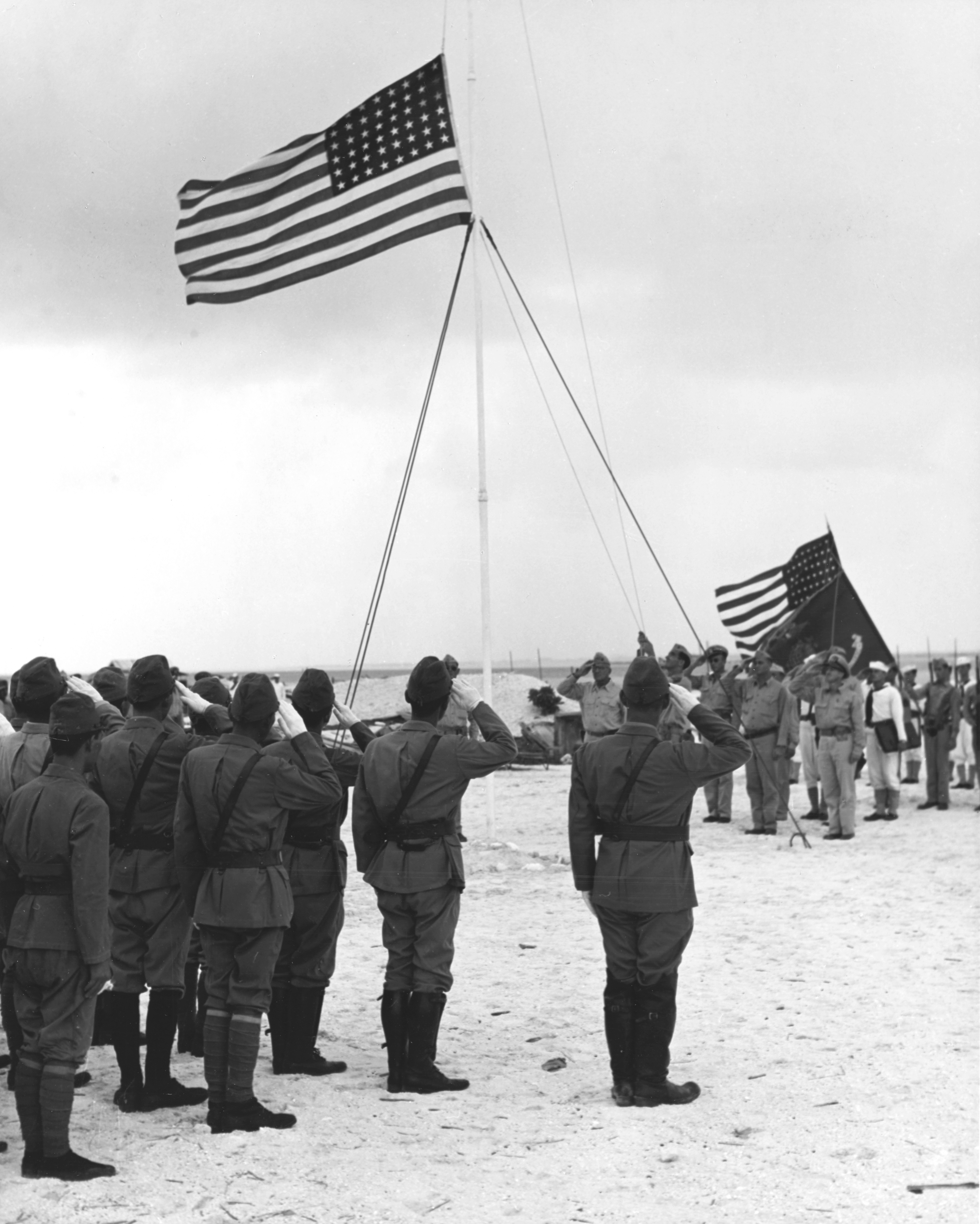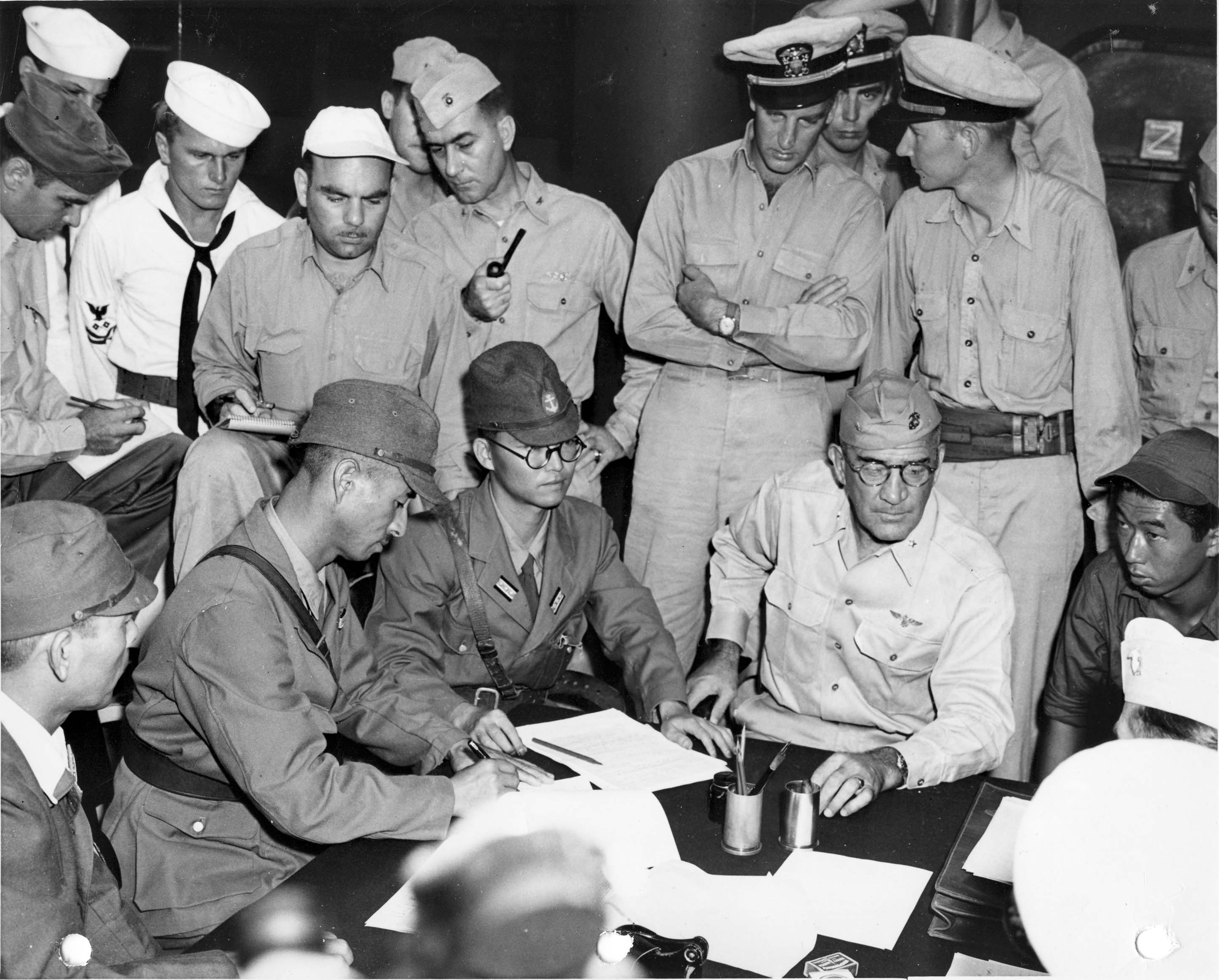Shigematsu Sakaibara on:
[Wikipedia]
[Google]
[Amazon]
 was an admiral in the
was an admiral in the
 After the war, Sakaibara, his subordinate, Lieutenant Commander Shoichi Tachibana, and Toraji Ito, was taken into custody by the American occupation authorities. They initially claimed that the victims were killed in a bombing raid by U.S. forces, but later confessed to the massacre.
Sakaibara, Tachibana, and Ito were extradited to Kwajalein Island, where they were tried for war crimes by a U.S. military commission. Ito killed himself in custody. Sakaibara and Tachibana were both found guilty and sentenced to death in December 1945. Tachibana's sentence was commuted to life in prison, and he was sent to Sugamo Prison to serve out his sentence. Sakaibara was extradited to
After the war, Sakaibara, his subordinate, Lieutenant Commander Shoichi Tachibana, and Toraji Ito, was taken into custody by the American occupation authorities. They initially claimed that the victims were killed in a bombing raid by U.S. forces, but later confessed to the massacre.
Sakaibara, Tachibana, and Ito were extradited to Kwajalein Island, where they were tried for war crimes by a U.S. military commission. Ito killed himself in custody. Sakaibara and Tachibana were both found guilty and sentenced to death in December 1945. Tachibana's sentence was commuted to life in prison, and he was sent to Sugamo Prison to serve out his sentence. Sakaibara was extradited to
The Defense of Wake
* {{DEFAULTSORT:Sakaibara, Shigematsu Japanese admirals of World War II 1894 births 1947 deaths People from Yamagata Prefecture Perpetrators of World War II prisoner of war massacres Imperial Japanese Navy admirals Japanese mass murderers Japanese people convicted of war crimes Executed Japanese people Executed military personnel Battle of Wake Island People executed by the United States military by hanging Japanese people executed abroad People executed for war crimes Executed mass murderers
 was an admiral in the
was an admiral in the Imperial Japanese Navy
The Imperial Japanese Navy (IJN; Kyūjitai: Shinjitai: ' 'Navy of the Greater Japanese Empire', or ''Nippon Kaigun'', 'Japanese Navy') was the navy of the Empire of Japan from 1868 to 1945, when it was dissolved following Japan's surrender ...
, the Japanese garrison commander on Wake Island
Wake Island ( mh, Ānen Kio, translation=island of the Sida fallax, kio flower; also known as Wake Atoll) is a coral atoll in the western Pacific Ocean in the northeastern area of the Micronesia subregion, east of Guam, west of Honolulu, sou ...
during World War II
World War II or the Second World War, often abbreviated as WWII or WW2, was a world war that lasted from 1939 to 1945. It involved the World War II by country, vast majority of the world's countries—including all of the great power ...
, and a convicted war criminal. He was responsible for ordering the Wake Island massacre, in which 98 American civilians were murdered by Japanese soldiers. Following Japan's surrender, Sakaibara was tried for war crimes and executed for his involvement.
Biography
A native ofYamagata prefecture
is a prefecture of Japan located in the Tōhoku region of Honshu. Yamagata Prefecture has a population of 1,079,950 (1 June 2019) and has a geographic area of 9,325 km² (3,600 sq mi). Yamagata Prefecture borders Akita Prefecture to the nort ...
in northern Japan, Sakaibara was a graduate of the 46th class of the Imperial Japanese Navy Academy in 1918, placing 36th in a class of 124. He served his midshipman
A midshipman is an officer of the lowest rank, in the Royal Navy, United States Navy, and many Commonwealth navies. Commonwealth countries which use the rank include Canada (Naval Cadet), Australia, Bangladesh, Namibia, New Zealand, South Af ...
tour on the cruiser ''Tokiwa'', and after his commission as an ensign
An ensign is the national flag flown on a vessel to indicate nationality. The ensign is the largest flag, generally flown at the stern (rear) of the ship while in port. The naval ensign (also known as war ensign), used on warships, may be diff ...
, was assigned to ''Hirado''. He later served on the destroyer ''Kaba'' and battleship ''Mutsu''.
As a sub-lieutenant, he served on the ''Iwate'' and after his promotion to lieutenant
A lieutenant ( , ; abbreviated Lt., Lt, LT, Lieut and similar) is a commissioned officer rank in the armed forces of many nations.
The meaning of lieutenant differs in different militaries (see comparative military ranks), but it is often ...
on December 1, 1924, he was assigned to the ''Hiei'', ''Yura'', and ''Sendai''. He was chief gunnery officer on the ''Tatsuta''. Promoted to lieutenant commander
Lieutenant commander (also hyphenated lieutenant-commander and abbreviated Lt Cdr, LtCdr. or LCDR) is a commissioned officer rank in many navies. The rank is superior to a lieutenant and subordinate to a commander. The corresponding rank i ...
in 1930, he served as chief gunnery officer on ''Takao'' in 1934, followed by ''Mutsu'' in 1935. He was executive officer
An executive officer is a person who is principally responsible for leading all or part of an organization, although the exact nature of the role varies depending on the organization. In many militaries and police forces, an executive officer, ...
on ''Chikuma'' in 1939. After his promotion to captain in 1940, he served in a number of staff positions.
After the Battle of Wake Island on December 23, 1941, Sakaibara was appointed the garrison commander of the Japanese occupation force. Fearing an imminent attempt by American forces to retake the island, Sakaibara put 98 American civilians they had captured to work building a series of bunkers and fortifications in preparation for a suspected amphibious invasion.
On October 5, 1943, aircraft from USS ''Yorktown'' bombed Wake Island. Two days later, Sakaibara ordered the beheading of an American civilian worker who was caught stealing. Fearing an invasion, Sakaibara ordered the rest of them to be killed. They were taken to the northern end of the island, blindfolded and machine-gunned. One prisoner (whose name has never been discovered) escaped, carved a message into a rock about the incident but was then recaptured and personally beheaded by Sakaibara.
However, despite the massive assembly, the attack never came. Instead the United States Navy
The United States Navy (USN) is the maritime service branch of the United States Armed Forces and one of the eight uniformed services of the United States. It is the largest and most powerful navy in the world, with the estimated tonnage ...
established a submarine blockade, causing the Japanese garrison to starve. United States forces bombed the island periodically from 1942 until Japan's surrender in 1945.
Sakaibara was promoted to rear admiral
Rear admiral is a senior naval flag officer rank, equivalent to a major general and air vice marshal and above that of a commodore and captain, but below that of a vice admiral. It is regarded as a two star " admiral" rank. It is often rega ...
a year later, on October 15, 1944. The Japanese garrison on Wake Island formally surrendered to the United States on September 4, 1945.
 After the war, Sakaibara, his subordinate, Lieutenant Commander Shoichi Tachibana, and Toraji Ito, was taken into custody by the American occupation authorities. They initially claimed that the victims were killed in a bombing raid by U.S. forces, but later confessed to the massacre.
Sakaibara, Tachibana, and Ito were extradited to Kwajalein Island, where they were tried for war crimes by a U.S. military commission. Ito killed himself in custody. Sakaibara and Tachibana were both found guilty and sentenced to death in December 1945. Tachibana's sentence was commuted to life in prison, and he was sent to Sugamo Prison to serve out his sentence. Sakaibara was extradited to
After the war, Sakaibara, his subordinate, Lieutenant Commander Shoichi Tachibana, and Toraji Ito, was taken into custody by the American occupation authorities. They initially claimed that the victims were killed in a bombing raid by U.S. forces, but later confessed to the massacre.
Sakaibara, Tachibana, and Ito were extradited to Kwajalein Island, where they were tried for war crimes by a U.S. military commission. Ito killed himself in custody. Sakaibara and Tachibana were both found guilty and sentenced to death in December 1945. Tachibana's sentence was commuted to life in prison, and he was sent to Sugamo Prison to serve out his sentence. Sakaibara was extradited to Guam
Guam (; ch, Guåhan ) is an organized, unincorporated territory of the United States in the Micronesia subregion of the western Pacific Ocean. It is the westernmost point and territory of the United States (reckoned from the geographic ce ...
for execution.
Just before he was sentenced, Sakaibara read out a final statement to the commission. He admitted that what he did was wrong and said he wished that he had never heard of Wake Island. However, Sakaibara also claimed that the United States had no moral authority to try him or others after using nuclear weapons on Japan. With that statement, many people in Sakaibara's hometown saw him as a victim of victor's justice.
Sakaibara was hanged
Hanging is the suspension of a person by a noose or ligature around the neck.Oxford English Dictionary, 2nd ed. Hanging as method of execution is unknown, as method of suicide from 1325. The ''Oxford English Dictionary'' states that hanging in ...
in Guam on June 19, 1947. Until the end, he maintained, "I think my trial was entirely unfair and the proceeding unfair, and the sentence too harsh, but I obey with pleasure."
References
Notes
Books
* * * *External links
*The Defense of Wake
* {{DEFAULTSORT:Sakaibara, Shigematsu Japanese admirals of World War II 1894 births 1947 deaths People from Yamagata Prefecture Perpetrators of World War II prisoner of war massacres Imperial Japanese Navy admirals Japanese mass murderers Japanese people convicted of war crimes Executed Japanese people Executed military personnel Battle of Wake Island People executed by the United States military by hanging Japanese people executed abroad People executed for war crimes Executed mass murderers